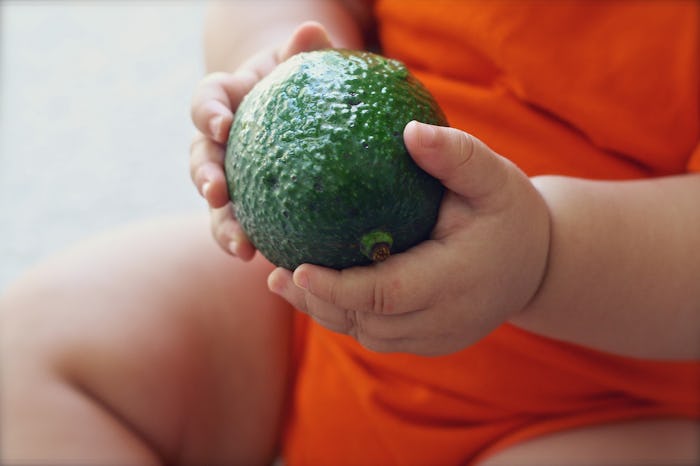Of all the milestones babies reach, starting solids was the one I looked forward to the most. After doing a lot of research — combined with my compulsive need to go against the "norm" — I decided to go with what I believed to be a more natural approach to feeding my baby solids. Much like baby-led nursing, baby-led weaning puts your baby in charge of what, when, and how much they eat, letting them explore different foods and, ultimately, become tiny, non-picky connoisseurs. Or at least that's the goal. But how do you get baby to do baby-led weaning? It's actually a super simple and intuitive process.
Although there's no one "right" way to teach your baby to eat, in my experience (and the experience of countless other moms who back the method,) baby-led weaning simply introduces complimentary foods to your baby's already established diet of breastmilk or formula, slowly adding in more and more until you're ready to stop nursing altogether. The beauty of baby-led weaning is that it looks differently for every family — sometimes taking months or longer. You don't have to spend hours pureeing foods or buy special food for your little one. Instead, you'd simply serve them samples of what you've already made for yourself and the rest of your family — teaching them healthy eating habits right from the start. If baby-led weaning appeals to you (and your already busy schedule,) keep these tips in mind before trying it out.
1Don't Start Too Early
The APA recommends waiting until your baby is at least six months old before introducing any solids — but with baby-led weaning, sometimes it's best to wait a bit longer. What to Expect notes that your baby should be able to sit up unassisted, and move things to their mouth. They should also have an irresistible interest in "adult food," often grabbing for what's on your plate.
2Redefine What Weaning Actually Means
When parents hear the word "weaning," more often than not they think of giving up breastfeeding or bottle feeding altogether. But that's not necessarily the case when it comes to baby-led weaning. According to the Baby-Led Weaning website, thinking of weaning as a transition period where your baby slowly moves towards eating more and more solids is a helpful definition of the term.
3Let Them Explore
Don't worry if your baby doesn't love everything they try right away. What to Expect noted that oftentimes babies need to try something up to four different times before they truly decide if they like or dislike it. Similarly, baby-led weaning is more about teaching your baby about healthy eating than actually feeding them a substantial amount (the majority of their nutrition will come from breastmilk in the first weeks or months.) Offer your baby a wide variety of safe foods (ie. no choking hazards like nuts, whole grapes, or common allergens at first,) to let them get used to lots of different things.
4Forego The Purees
Proponents of baby-led weaning say that purees are totally unnecessary, even though rice cereal and pureed fruits and veggies are the mainstay of typical weaning. Parents noted that feeding baby purees first teaches them to swallow without chewing, while giving them manageable solids teaches them how to chew, gnaw, and move their food around first before swallowing it. Start with small strips of fruits, veggies, and meats and let your baby play, eat, and work with it.
5Be Patient And Try Lots Of Different Foods
Baby-led weaning isn't quitting breastfeeding cold turkey. Instead, it's a process that requires patience (and lots of fun too.) Baby-Led Weaning recommended that parents be flexible, not sticking to a rigid feeding schedule, and try lots of different foods. Let your baby eat when you do, sampling different things from your plate. Eventually, they'll be the tiny connoisseur that every parents dreams of.
